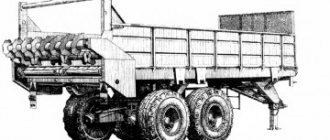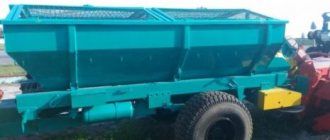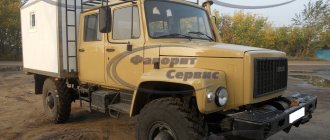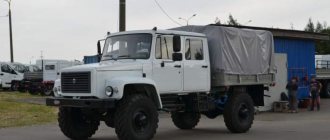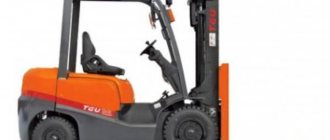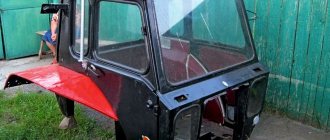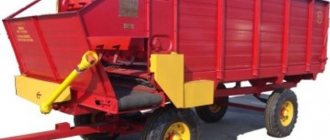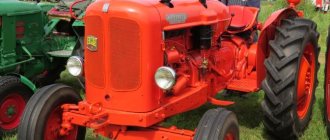Solid organic fertilizers:
- manure
- peat
- compost.
contributed in the following ways:
Using the non-transshipment method , fertilizers are delivered over a distance of 4-8 km and scattered across the field using trailer-type spreaders such as PRT-10 and others, mounted on tractors of the 1.4-5 traction class.
The transshipment method involves the delivery of fertilizers in the autumn-winter period by dump trucks or tractor dump trailers to the edge of the field in piles, from where they are reloaded in the spring into spreader trailers, simple or low-bed, and applied to the soil.
With two-phase technology, fertilizers transported to the fields are dumped into heaps, from which they are then scattered using rake-spreaders coupled with tractors of traction class 3.
PRT-10
The trailed tractor spreader (PTS) is designed for the main continuous application of solid organic fertilizers.
The equipment is also used for transporting and self-unloading agricultural goods.
Organic fertilizer spreaders recognized in Russia
Spreaders are widely used in the agricultural sector for transporting and applying masses of organic fertilizers. They are indispensable when working with manure, humus and peat. There are models for solid bulk matter and for liquid or excessively wet fertilizer. This feature allows you to select the necessary equipment depending on its future use.
Organic fertilizer spreaders
This type of agricultural machinery has a number of features. They, in turn, are determined by the type of device:
- Spreaders for masses of solid and bulk fertilizers, which are most often manure and peat, are characterized by high productivity. Features of this type of technology itself:
- The large-volume body has a streamlined shape, which promotes good discharge of fertilizers.
- The capacity of the body can be increased by adding special linings to it.
- The conveyor, which moves organic fertilizer in the body, is made of especially strong steel chains.
- Knives that crush organic fertilizers can be replaced if there is significant physical wear. This feature generally extends the service life of the entire spreading device.
- Uniform spraying of organic fertilizers and operational efficiency are due to the presence of special hooks, which are located in the spreading device.
Principle of operation
All parts of the spreader are powered by the tractor with which the machine is coupled. Initially, a shaft is driven, which transmits rotation to the gearbox of the equipment. The next step is the parallel launch of drums and conveyors. This mechanism is responsible for moving the mass of organic fertilizer to the spreading device. Special grinders process the fertilizer and send it into the spreader nozzles. The spirals responsible for this process are capable of scattering mass over a distance of up to 8 meters.
Review of popular models
The Belarusian enterprise Bobruiskagromash was founded in 1974. Now it is a leading manufacturer of machines for working with organic fertilizers, whose products are supplied to countries near and far abroad. The following spreader models are in particularly high demand:
PRT-10
This model works optimally with tractors of the third traction class. The machine is capable of not only spreading solid organic fertilizers in a continuous manner, but also transporting them to the place where agricultural work is carried out.
Technical characteristics of the PRT-10 fertilizer spreader:
| Characteristics | Unit measurements | Indicators |
| Load capacity | T | 11 |
| Performance | t/hour | 40 |
| Width of treated surface | m | 7-10 |
| Consumption | t/ha | 20-60 |
| Weight | T | 3,7 |
| Length | m | 7,1 |
| Width | m | 2,5 |
| Height | m | 2,7 |
Video review of the organic fertilizer spreader PRT-10:
The equipment is designed to work with tractors of classes 2 and 3. The model's chassis has a special mechanism that ensures stability when working on soft soil. The moving elements are reliably protected from moisture by a special sealed compound.
Technical characteristics of the PRT-7 spreader:
| Characteristics | Unit measurements | Indicators |
| Load capacity | T | 7,3 |
| Width of treated surface | m | 5-8 |
| Consumption | t/ha | 10-60 |
| Weight | T | 3 |
| Length | m | 6,1 |
| Width | m | 2,5 |
| Height | m | 1,9 |
Photo of organic fertilizer spreader PRT-7
PRT-16
The model has an increased load capacity. This is especially important when working on large areas. The equipment works with solid fertilizers in terms of surface continuous application. Class 3 tractors are optimal for aggregation.
Technical characteristics of the PRT-16 model:
| Characteristics | Unit measurements | Indicators |
| Load capacity | T | 16 |
| Width of treated surface | m | 5-8 |
| Consumption | t/ha | 15-45 |
| Weight | T | 5 |
| Length | m | 8,2 |
| Width | m | 2,5 |
| Height | m | 2,65 |
Photo of fertilizer spreader PRT-16
Device
The PRT-10 organic fertilizer spreader is a trailer consisting of a welded frame, chassis, body, metering conveyor, rotary spreading device, drive mechanism, brake system and electrical equipment. The body consists of the main and tipper sections. The latter is pivotally connected to the frame and can be tilted using hydraulic cylinders. The chassis consists of a tandem-type balancing suspension and a dolly. When moving in reverse, the latter is fixed with a locking device that prevents the trolley from rotating around a vertical axis. The spreading device and conveyor are driven from the tractor PTO through a cardan drive, transmission shafts, a bevel-helical gearbox, a spur gear, two spur gearboxes and several chain gears.
PRT-10: 1 — dolly; 2 — cardan transmission; 3 and 4 — body sections; 5 and 9 — gearboxes; 6 — spreading device; 7 - electrical equipment; 8 — replaceable sprocket; 10 — balance suspension; 11 — brake system; 12 - frame; 13 — conveyor-dispenser.
When the tractor PTO is turned on, fertilizers are supplied to the spreading device only from the main section. 10-15 seconds after the start of spreading, the hydraulic cylinders of the tipping device of the dump truck section are turned on, and the fertilizers are loaded into the main section. The conveyor picks up the incoming mass and delivers it to the spreading elements. After the dump section is emptied, the hydraulic system is turned off and the dump section is lowered under its own weight.
Fertilizer application rate (at the speed of movement of the organic fertilizer spreader PRT-10
10 km/h and a working spreading width of 5-6 meters) are adjusted by changing the conveyor speed by changing the sprocket. With a number of teeth of 13, 20 and 28, the application rate will be 20, 40 and 60 t/ha, respectively.
Organic fertilizer spreader trailer PRT-16
Designed for transportation and surface application of manure, peat-manure compost and other types of organic fertilizers into the soil, as well as for transportation of various agricultural goods with their unloading by the body conveyor back. Main components: frame, two-section body, chassis system, feed conveyor, spreading device and conveyor drive mechanism, hydraulic system, pneumatic system and electrical equipment. Drive of working parts from the tractor PTO. It is aggregated with the K-701 tractor. Recommended for zones: 1, 2, 4-9, 11, 13, 14-19.
Tractor spreader trailer prt-16a
P
Designed for transportation and continuous surface application of organic fertilizers, as well as for transportation of various agricultural goods with unloading by a conveyor back (with the spreading device removed). Load capacity 16 tons.
It consists of a frame, a body, a feeding conveyor, a spreading device, a drive mechanism for the spreading device and a conveyor drive, a running system with brakes, and electrical equipment.
Changes have been made to distinguish the PRT-16M from the PRT-16:
Auxiliary lift body and hydraulic body control equipment are excluded,
The front side of the body is inclined,
In the front part of the body there is an extension side with a length of 2600 and a height of 250 mm,
Conveyor length increased by 1080 mm,
The rotation speeds of the spreading bodies have been increased,
Reduced frame length.
Changing the dose of fertilizer is carried out by rearranging the sprockets in the conveyor drive mechanism. The work is carried out using the shuttle method.
Machines for applying organic fertilizers are divided into spreaders for applying loose fertilizers (manure, peat chips, peat manure-mineral mixtures) PRT-10, PRT-16, ROTs-5, RTO-5, etc. and liquid fertilizers such as MZhT-10, MZhT-16, MZhT-3.6, etc.
The PRT-10 fertilizer application machine consists of a frame, a body, a chain-needle conveyor (not shown in the figure), a spreading device, running wheels, a parking support device and a transmission mechanism with a gearbox. The drive is carried out from the tractor PTO, through the shaft.
Fertilizers located in the body are brought by a chain-slat conveyor with a tensioning device to the spreading device, which crushes them and scatters them across the field.
Liquid organic fertilizers are applied by spreading them superficially or subsoil using feeding paws or other devices. Liquid fertilizer spreaders RZhT-4, RZhT-8, RZhT-16, ZZhV-F-3, 2, MZhT-10 (with and without a device for intra-soil application of liquid fertilizers), MZhT-16, etc. are used for these purposes. .
The machine for applying liquid manure MZh-10 consists of a tank with a capacity of 10.4 m, a centrifugal pump, a vacuum unit, a filling hose mounted on a rotating rod, a pressure pipeline, switching and dispensing devices, vacuum and liquid safety valves and a hydraulic system.
The tank has upper and lower hatches with hermetically sealed lids. To visually determine the completeness of filling the tank, a float level gauge is installed.
To create a vacuum in the tank when filling it, a vacuum unit is mounted on the machine, consisting of two rotary pumps. The suction manifold of the pumps is connected by a pipeline to the body of the liquid safety valve, inside of which two hollow balls are located.
A centrifugal pump, driven by the tractor's PTO shaft, pumps liquid from the tank into the pressure pipeline.
The switching device is used to configure the machine to perform various operations. It includes an upper valve located on the inside of the tank, a lower valve, a hydraulic cylinder, a lever and a rod mounted on the pipe. The latter connects the pressure pipeline to the internal cavity of the tank.
The filling device is used for dosed distribution of fertilizers over the field surface. It consists of a pipe, a valve and a distribution panel, the inclination of which can be changed.
The machine can perform: self-loading of liquid fertilizers from a manure storage facility, mixing them during transportation and applying them to the fields.
Bootstrap . The flap of the filling device is closed with a valve, the rod with the sleeve is lowered into the manure storage using a hydraulic cylinder, and the vacuum unit is turned on. A vacuum of up to 0.061 MPa is formed in the tank, under the influence of which the liquid mass fills the tank through the hose. As soon as the liquid, having reached the upper level, lifts the ball-valve to the stop, the vacuum pipeline pipe, the supply of fertilizers stops. After filling the tank, the rod is placed in the transport position and the vacuum unit is turned off.
Stirring . The damper is opened by a hydraulic cylinder, and the damper is closed and the pump is turned on. The liquid from the reservoir enters the pump and is pumped through a pipeline and pipe into the reservoir, i.e. circulates in a circle and mixes. This prevents liquid separation and sediment formation.
Fertilizer application . A centrifugal pump is switched on, which supplies liquid through a pipeline into the nozzle of the filling device. At the same time, the damper is closed and the damper is opened. Coming out through the hole in the valve at high speed, the liquid hits the shield and is distributed like a fan over the surface of the field.
To change the dose of fertilizer application, the machine is equipped with valves with holes with diameters of 60, 90 and 110 mm. The size of the valve opening and the operating speed of the unit are selected according to the table. To apply 40-60 tons of fertilizers per 1 hectare they work without valves.
The MZhT-10 is aggregated with the T-150K, Belarus-1522, and Belarus-1321 tractors. Working width 6-12 m.
The LVV-F-2.8 unit is designed for subsoil application of liquid organic fertilizers and organic-mineral mixtures with a moisture content of at least 92% in meadows, pastures, as well as stubble fields at a width of 2.8 m. Operating speed - up to 6 km /h.
The unit is made up of an MZhT-10 machine and a device for subsoil application of fertilizers attached to it.
Organic fertilizer spreaders PRT-10, PRT-16, PRT-7: characteristics, features, photos
www.kartoffeltechnik.ru Potato equipment, potato planters, potato harvesters.
www.agrozip.ru Spare parts for agricultural machinery.
www.newtechagro.ru Agricultural machinery, spare parts (spare parts) Amazon.
www.chesnok.info Garlic, garlic growing technologies, garlic harvesting.
www.agromonitoring.ru Parallel driving systems, direction indicators, precision driving, precision farming technologies.
www.separ2000.com SEPAR 2000 Separ is the only fuel filter in the world today with 100% water separation according to DIN ISO 4020 and 96% dirt separation.
www.aquaspray.ru Irrigation systems of coil type Ocmis - Okmis Circular, linear, frontal, hippodrome irrigation RKD - RKD Drip irrigation Netafim - Netafim.
Our website is not a public offer, defined by the provisions of Article 437 (2) of the Civil Code of the Russian Federation, but is for informational purposes only. For accurate information about the availability and cost of goods, please contact us by phone. In case of copying or using any material located on the website www.agro.ag, an active link is required, in case of printing - a printed link. Copying the site structure, ideas or site design elements is strictly prohibited. The rights to all trademarks, images and materials presented on the site belong to their owners.
Spreader trailer PRT-16
Designed for transportation and surface application of manure, peat-manure compost and other types of organic fertilizers into the soil, as well as for transportation of various agricultural goods with their unloading by the body conveyor back.
Main components: frame, two-section body, chassis system, feed conveyor, spreading device and conveyor drive mechanism, hydraulic system, pneumatic system and electrical equipment.
Drive of working parts from the tractor PTO.
It is aggregated with the K-701 tractor. Recommended for zones: 1, 2, 4-9, 11, 13, 14-19. Technical specifications
| Working width, m | 6-7 |
| Productivity per hour of pure work, t | 100 |
| Load capacity, t | 16 |
| Operating speeds, km/h | 10-12 |
| Fertilizer application rates, t/ha | 20-60 |
| Loading height, mm: along the platform floor along the sides of the dump body | 1400 2320 |
| Number of wheels | 6 |
| Tires | 1065X420X457 (K-59) |
| Track, mm | 2050 |
| Ground clearance, mm | 390 |
| Overall dimensions, mm: length width height | 8920 2520 2630 |
| Structural weight (mass), kg | 6025 |
| Maintenance personnel (tractor driver) | 1 |
| © 2010-2017 "agro.ag". All rights reserved. | Tel. Email |
In accordance with the requirements of the Federal Law “On Personal Data” No. 152-FZ of July 27, 2006, all personal data received on this site is not stored, not transferred to third parties, and is used only for sending goods and executing the application received from the buyer . All persons who filled out the application form confirm their consent to the use of personal data such as name and telephone number specified in the application form for processing and sending the order. There is no storage of personal data.
Organic fertilizer spreaders recognized in Russia. Organic fertilizer spreader
Organic fertilizer spreader ROU-6: features, design, technical specifications
To get a good harvest, it has long been customary to feed the soil in the fields with organic matter: manure, peat, chicken droppings. But if earlier this was done manually, spreading fertilizer with shovels, now everything is much simpler. A special spreader machine called ROU-6, attached to a tractor, will fertilize the field much more accurately and quickly.
Organic fertilizer spreader ROU-6
This four-wheeled unit, equipped with a body, is a product of the Belotserkovselmash enterprise, which has been producing various agricultural machines since 1850. The spreading mechanism operates from the tractor power take-off shaft. If necessary, it can be easily removed, and then you get a trailed tractor trolley.
Purpose of the machine
This mechanical assistant in tandem with a tractor can easily cope with large volumes of any organic matter. In a short time, all of it will be distributed over the surface of the field. This can be peat or compost, manure (both litter and non-litter types), all kinds of organic waste (for example, food), sapropel, sludge, bird droppings.
The spacious body of the fertilizer spreader with a volume of 3.6 cubic meters can be easily expanded with add-on sides. By disconnecting the spreading beaters, it is possible to transport the necessary agricultural loads in it, unloading them from the rear using a conveyor.
Advantages and disadvantages
- Good transport speed.
- Large spreading width – up to eight meters.
- A spacious body that allows you to transport cargo.
- The device operates on the principle of continuous application of fertilizers, which is more efficient and uniform than spreading from heaps (using the RUN-15 unit). And the earth becomes less compacted.
- A convenient and fast conveyor that unloads the body in three to five minutes.
The only drawback is that the unit is not self-propelled - a traction device is required for its operation.
Photo of organic fertilizer spreader ROU-6
Design
On a durable metal frame stands a body equipped with a scraper conveyor, which is needed to move fertilizer to the spreading mechanism or to speed up unloading work. The conveyor consists of four chains with scrapers attached to clamps. The tension of each line of the chain mechanism is regulated by special tension bolts that move the shafts with rollers. The power take-off shaft drives the conveyor.
The cardan shaft is of the telescopic type. The gearbox, fixed to the frame with bolts, is a bevel-cylindrical type and consists of two stages. The movement from the spreader shaft (connected to the gearbox by a chain clutch) is transmitted first to the chopping drum, and then to the spreading drum. For this purpose, bushing-roller chains are used.
The chassis (tandem type) includes two separate pairs of wheels with balancers and bearing supports. The brake system operates from the tractor pneumatic line through a special adapter, the rod of which is activated when the driver presses the pedal. Brake fluid is supplied to the cylinders on the wheels, and the car is stopped by the brake pads.
The electrical wiring plug and wiring harness are located inside the frame. The electrical part, powered by the tractor, includes the rear lights, as well as lights that illuminate the license plate and light reflectors. Mains voltage is 12 volts. Before work, you must connect the plug to the tractor's electrical system.
Specifications
Technical characteristics of the organic fertilizer spreader ROU-6:
| Characteristics | Indicators | Unit measurements |
| Device type | trailed | |
| Tractor traction class | from 1.4 | |
| Load capacity (maximum) | 6 | T |
| Performance | up to 52 | t/h |
| Chopping drum rotation speed | 385 | rpm |
| Speed (transport) | 28 | km/h |
| Fertilizer placement width | 4-8 | m |
| Fertilizer application rate | 1-6 | g/m2 |
| Height (loading, on platform floor) | 1,25 | m |
| Body volume (standard sides) | 3,6 | m3 |
| Track | 1,86 | m |
| Longitudinal base | 3,73 | m |
| Clearance | 0,35 | m |
| Weight (with spreading mechanism) | 2 | T |
| Weight (without spreading mechanism) | 1,835 | T |
| Length | 5,9 | m |
| Height (by spreading mechanism) | 1,85 | m |
| Width | 2,25 | m |
The video shows the ROU-6 organic fertilizer spreader in operation:
Organic fertilizer spreader. Great encyclopedia of technology
Organic fertilizer spreader
Organic fertilizer spreader is a machine designed for spreading composts, peat chips and other organic fertilizers.
There are spreader trailers, heap fertilizer spreaders, and liquid fertilizer spreaders.
The spreader trailer 1-PTU-3.5 consists of a frame with running wheels, a body with a feeding conveyor, a spreading device and a drive mechanism. The welded frame has a towing device; a support post is pivotally attached to it, which in parking lots is used as a third point of support, since the trailers are single-axle. After connecting the trailer to the tractor, the stand is raised and fixed. The spreader body is all-metal. The side panels are hinged and can be opened and secured in an inclined position. To prevent fertilizers from being thrown towards the tractor, the front side is extended with a removable rear side. The conveyor consists of four welded calibrated chains with metal strips; it is mounted at the bottom of the bunker. The conveyor chains are combined in pairs. Each of the two branches has its own tensioning device, consisting of a shaft moved by tension bolts, on which the driven rollers of the chains rotate freely. The chains are collapsible, they consist of separate sections of nine links, which are connected by special links, and stamped metal strips are attached to them by soldering. Each branch has twenty-three slats. The drive shaft with sprockets is common for all chains. The spreading device consists of two drums. The lower drum with a spur-shaped surface is a grinding drum, it is installed in the body; The upper auger-shaped drum is a spreading drum, it is located outside the trailer body. This design of the drums completely eliminates the jamming of solid objects between them, crushes long-straw inclusions of manure well and ensures their spreading over a width of up to 5 m. The working parts of the spreader trailer are driven by the tractor power take-off shaft. The movement is transmitted by a cardan shaft through a longitudinal shaft with a safety clutch to a two-stage bevel gearbox mounted on the frame beams. From it, one shaft rotates the lower drum through a chain transmission, and from it, the upper drum is driven by a chain. Another gearbox shaft communicates movement to the ratchet mechanism of the feed conveyor drive; it makes it possible to regulate the speed of the conveyor and change the rate of fertilizer application. A crank is rigidly mounted on the gearbox shaft, and a connecting rod pin is installed in its groove. By installing it at different distances from the shaft, you can change the radius of the crank. A ratchet wheel is mounted on a key on the conveyor drive shaft. On both sides of the shaft there are two cheeks, they are connected by an axis on which the drive pawl and connecting rod are mounted. The pawl tooth is pressed against the toothed surface of the ratchet wheel under the action of a spring. When the connecting rod moves, the cheeks oscillate and rotate at a certain angle. The pawl, engaged with the ratchet wheel, turns it and at the same time the conveyor shaft to exactly the same angle. When the cheeks move back, the pawl slides along the ratchet wheel, which is kept from moving by the second pawl. The larger the radius of the crank, the greater the stroke of the feed conveyor and the more fertilizer the machine can scatter. It can be converted to apply mineral fertilizers and lime using a removable attachment with a rubber ring thrower. The industry produces heavy-duty spreader trailers with a lifting capacity of 10-16T: PRT-10 and RPB-16.
The RUN-15A spreader consists of a windrower, an active working element, a rotary spreader, a windrower lifting mechanism and a transmission system. The swather consists of two side and rear walls (similar to a bulldozer hitch) and is mounted in front of the tractor. During operation, the side walls rest on the rollers. There is a dosing window in the rear wall; its size and, accordingly, the shape of the roller can be changed using special shutters. The fertilizer is directed into the dosing window by an active working element, consisting of a double-armed lever, at one end of which there is a pusher, and at the other there is a hydraulic cylinder with a spool drive. The pusher breaks up large clods of fertilizer, helping to form a continuous windrow. A rotary spreader is mounted behind the tractor, which consists of two rotors and two support rollers. The rotors are driven by the tractor's power take-off shaft through a cardan shaft, a single-stage gearbox and two chain drives, and they scatter a swath of fertilizer on both sides of the tractor. The spreader has a working width of up to 20 m. It can also be used to pull fertilizers from piles into piles. The dosing window is closed with flaps, and the spreading device is raised - in this way the machine is converted into a bulldozer.
The vacuum slurry refiller-spreader 3ZhV-1.8 is intended for pumping slurry from slurry containers and transporting it to the field with subsequent spreading over the soil surface. The liquid spreader consists of a single-axle chassis on pneumatic wheels, a tank, an intake hose, a pressure-vacuum system, an ejector, a shutter, a pouring tray, an air mixer and a level gauge.
The tank with a capacity of 1.8 m3 is made of steel. Its internal surface is covered with anti-corrosion enamel, there is an inspection window in front, a neck is located on top, and a two-section shutter with two levers for the intake hose and the filling tray is installed at the back. The intake hose is reinforced, corrugated from rubberized fabric, 4 m long, its diameter is 7.5 cm. The filling device is equipped with a pipe with replaceable nozzles, which allows you to adjust the rate of liquid application. The spill can be stopped from the tractor cab using a cable. A pressure-air system pipe is welded to the neck of the tank; it is connected by a pipeline to an ejector installed on the exhaust pipe of the tractor. The tank is filled in 7-10 minutes; to do this, it is necessary to close the tap of the filling device, open the tap of the intake hose, lower the hose into the liquid collector, close the damper on the ejector and increase the rotation speed of the tractor engine shaft. The exhaust gases will enter the narrowing channel (diffuser) through the pipe, where their speed will become even greater. A vacuum is created in the elbow; it will be transmitted through the pressure-vacuum line to the tank, which will begin to fill with liquid. You can control the filling level through an inspection window and a float-type level gauge. After filling the tank, the hose valve is closed and the ejector valve is opened. During a liquid spill, the valve of the filling device is opened, and the flaps on the ejector are closed. The gases will flow into the elbow and through the pressure-vacuum line into the tank, in which excess pressure will result. To mix the liquid in the tank, there is an air mixer made in the form of a pipe bent at an angle of 90° with twelve holes arranged in two rows. The lower end of the pipe is plugged, the upper end comes out of the tank, and when not in use it is closed with a plug. During transportation of liquid, the cap is opened, a vacuum is created in the tank using an ejector, air enters the holes of the mixer, enters the tank and mixes the liquid. This machine can also be used for preparing composts with slurry and transporting various chemicals and filling machines with them.
The ZU-3.6 liquid-spreader tanker is similar in design, principle of operation and purpose to the previous ones. The difference is that the refueling rod, consisting of a riser, a pipe, hoses, a turning mechanism and two hydraulic cylinders, is controlled by the tractor driver from the cab. He lowers it into the liquid collector, operating the levers, and after refueling, installs it on the car. There is a safety valve in the neck of the tank. The wheels are equipped with shoe brakes.
The RZHU-3.6 liquid fertilizer spreader is installed on the chassis of the GAZ-53A vehicle. In addition to the safety valve, there is a safety device on the tank neck cover to automatically stop the car engine if the tank is already full. The pump is driven by a hydraulic motor. The pressure-vacuum line consists of a rotary vacuum pump and a system of air ducts with taps, thanks to which it is possible to create a vacuum for refueling or excess pressure for dispensing liquid. There is a paddle mixer in the tank.
Liquid manure spreaders RZhT-4 and RZhT-8 are used for transporting, mixing and continuous surface distribution of slurry, for filling machines with various working fluids, for preparing composts, washing cars and extinguishing fires. These are semi-trailer tanks, the front part resting on the hydraulic hook of the tractor, and the rear part on pneumatic wheels. The difference from the previously discussed units is that they are equipped with two pumps: a vacuum pump for refueling and a centrifugal feed pump for dispensing fertilizers. Both pumps are driven by the tractor's power take-off shaft via a shift clutch. The tanks are equipped with a jet hydraulic mixer, which is powered by a centrifugal pump.
Share on the page
organic fertilizer application machines
MINISTRY OF AGRICULTURE OF THE RUSSIAN FEDERATION
Department of Education and Personnel Policy
Federal State Educational Institution
Perm State Agricultural Academy named after Academician D.N. Pryanishnikova
Department of Agricultural Machines
Organic fertilizer application machines
(Tutorial on the design, adjustment and preparation of machines for operation)
The textbook was compiled by Professor V.S. Kirov. in accordance with the program of the discipline “Agricultural and land reclamation machines”, approved on 07/05/96 and intended for students of the Faculty of Engineering in specialty 311300 - Agricultural mechanization.
The first version of the manual was compiled in 1990, was successfully tested in the educational process and was updated in 1994. Since the textbook was used in all faculties, there was a need to replicate it in order to place part of the publication in the reading room and library to ensure independent work for students.
For each machine, the manual is compiled mainly according to the following scheme: purpose, technical characteristics, general design and components, technological process and basic adjustments. The section on preparing machines for operation reflects possible machine malfunctions and how to eliminate them.
The textbook was reviewed at a meeting of the methodological commission on November 11, 1999 (protocol No. 3) and recommended for publication.
Machine for applying organic fertilizers PRT-10.
Machine for applying organic fertilizers PRT-10. It is used for the same purposes as the ROU-5 spreader. It is aggregated with the energy-rich T-150K tractor. The design of the PRG-10 machine is similar to the ROU-5, but has some features in the device. The difference between the spreader semi-trailer is that the two branches of the conveyor are driven continuously through a cardan shaft with a safety clutch, a bevel-helical gearbox, chain drives, spur gearboxes, drive shafts and final chain drives. Changing the seeding rate of organic fertilizers is achieved by installing sprockets with different numbers of teeth (2= 13, 2=22 and 2=28) on the drive shafts of the conveyor branches. The spreader wheels have a normal pneumatic block-type device. The machine has a mechanical parking brake. Students must carefully and consistently inspect the spreader semi-trailer. Compare it with previously studied ones and point out the features in its design. Loader-excavator PE-0.8B. Mounted on the YuMZ-6L16M tractor; Designed for loading and unloading and excavation work in agriculture. Repeat the general structure of the loader-excavator. Inspect the structure of the frame, the way it is attached to the side members of the tractor frame. Pay attention to the fastening of the support jacks, the rotary column to the main frame of the loader, the boom with an extension and the working element to the rotary column. Check the dozer blade connection. Study the hydraulic communications) of the loader. Find out the path of oil movement in the hydraulic system and the design features of hydraulic cylinders. Start the tractor engine, lower the support jacks until they touch the supporting surface to stabilize the backhoe loader and move the boom from the transport position to the working position. Check the operation of the bucket and monitor the action of the working cylinders. Test the operation of the hydraulic cylinder of a bulldozer blade. Move the boom with the bucket to the transport position, placing it on the stand. Turn off the engine. To ensure stable operation of the bulldozer, pour 150 kg of ballast into its dump through the hatch. Machine for applying organic fertilizers RZhT-8. Repeat technical specifications. Inspect the structure of the tank-semi-trailer, and since the tank is a supporting structure, it is necessary to clearly understand the method of mounting all the assembly units on it: the trailer, the block with brackets for connecting to the balancer suspension, the self-loading and pressure-switching device, pumps, gearbox and other parts of the machine . Study the kinematics of the drive of the working parts from the tractor power take-off shaft through the cardan shaft, the counter-drive, which transmits rotation to two vacuum pumps using a two-groove pulley and belts: using a chain clutch to a bevel gearbox and a three-robe pulley to the feed centrifugal pump. Find out the working process of the machine when self-loading the tank and distributing fertilizers over the field surface. Familiarize yourself with the design and principle of operation of the brake system of the vehicle chassis, including pneumatic and manual mechanical drives; they work independently of each other. Inspect the electrical equipment of the machine - lighting, alarm and electrical wiring devices.
